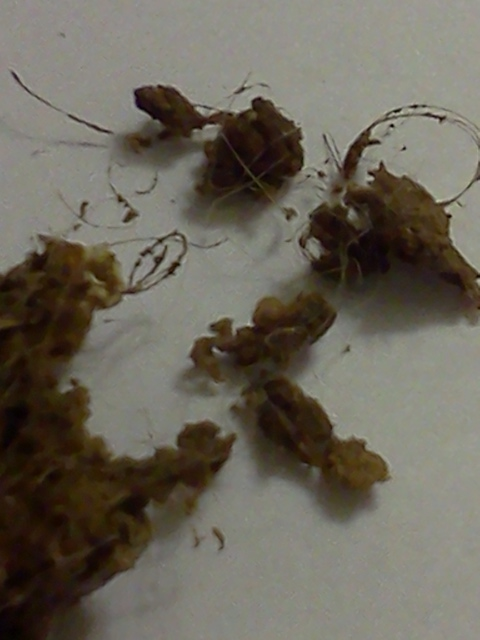QuestionI have a chiauchiau that is 6 years old. Male. he has his right eye red and irritated kind of watery. And the ear on that side seems to be itching him. It looks to me that he is suffering from allergies. His eating habits are good. But he is constantly scratching the right side of his face and ear. What could this be?
AnswerHi Cynthia,
Thank you for writing to me about your Chi. They are one of my favorite breeds.
There are numerous reasons for your precious munchkin's eye and ear to be bothering him. It is recommended that he be examined by your vet to determine the exact cause. Once you know whether it is allergies or mites or something
else, you can decide on how you want to treat it.
Below is some information that you might find to be useful.
From your description, it is possible that your precious
furball is suffering from allergies. It is likely the food he is eating but you would want to explore all the cleaning agents you use, the lawn care products, new carpets, etc. I personally only use Dr. Bronners and
vinegar to clean with. In the bathroom I use a small amount of chlorox and then clean over that with Dr. Bronners.
Food May Be the Cause of Your Dog's Skin Problems.
Food allergies or sensitivities are usually the last suspect in detecting the cause of a dog's skin problems. Most dogs are fed the same type of dog food for years, so the food is rarely suspected. Dogs, like humans, can
develop a sensitivity to any food or additive at any time.
It is estimated that 10 to 15 percent of all allergic skin diseases in dogs is caused by food allergy.
Common Ingredients
Dog food is made up of a combination of ingredients. The most common ingredients that can cause problems in a dog include:
beef
chicken
corn
eggs
fish
lamb
milk
preservatives
pork
soy
wheat
whey
Symptoms
Itchy skin is the primary symptom a dog suffers from food sensitivities.
Other symptoms may include:
anal itching
ear inflammations
hair loss
licking front paws
loss of appetite
face rubbing
head shaking
These following symptoms may manifest but are rare:
asthma like symptoms
behavioral changes
diarrhea
flatulence
seizures
sneezing
vomiting
Steps of Prevention
Be sure to eliminate all the foods in the dog's diet that match the list above, and feed your dog a commericial or homemade diet consisting of ingredients your dog has never eaten before.
The homemade diet should consist of two parts starch and one part protein.
Although duck, salmon, soy, venison, and rabbit are suggested for the protein; and rice and potatoes for the starch; rice is not always safe substitutes.
I generally recommend duck(or fish)and potato based foods for dogs.
You may be able to select a special commercial dog food blend that suits your dog's needs.
Whatever diet you choose for your dog, it should be the only food your dog ingests during the elimination period.
This means no table scraps, dog biscuits, dog bones, rawhide chews, vitamins, minerals or chewable heartworm pills. This elimination diet is
only temporary and once you find out what your dog is allergic to you must start to add other ingredients to make a complete meal for your dog.
If symptoms begin to improve during the elimination period, you can then re-introduce each of the eliminated food items one at a time. Each food should be tested for a week before another is introduced. This will allow you to pinpoint which foods may be causing problems if symptoms resurface.
Once the offensive food is discovered, then reading dog food labels should help you pinpoint a food that meets the needs of your dog. Although there are many hypoallergenic dog foods on the market, be sure to read the
labels carefully. Foods like Solid Gold Fish and Potato might work wonders for your dog. You can also try Spot's Stew, Avoderm, Venison, Rabbit, Paul Newman etc, or continue to make your own food at home. At least that way the food is fresh and you know what has gone into it. A
helpful book is Natural Health for Dogs and Cats by Dr. Pitcairn.
There is a site on dog health which includes great information about allergies and the best way to feed your dog. I urge you to spend some time studying the information that this wonderful site has to offer.
http://www.shirleys-wellness-cafe.com/animals.htm
I would also like to suggest that you have a complete thyroid panel done and don't accept a high or low normal reading, as normal. If it is not right in the middle, then ask for medication to bring it there.
Finally, you might consider having a consultation with Dr. Kruesi (do a search on google for his website). He is a brilliant nutritionist and althought he is located in Vermont, he does phone consultations. He may ask for additional tests in order to evaluate the reason for your dog's condition.
It used to be that flea-allergy dermatitis, which is an allergic skin reaction to flea bites, was the most gnawing concern of pet owners. But with the advent of more effective flea-control products, the incidence of
flea-related allergies has declined dramatically.
Taking their place as the greatest causes of itching and scratching in pets are environmental, or inhalant, allergies and food allergies. Environmental
allergies are usually caused by airborne allergens such as grasses, weeds, mold and dust mites. Common ingested allergens are proteins such as beef,chicken, soy and carbohydrates such as corn or wheat.
Environmental allergies are extremely common in dogs,
affecting as much as 15 percent of the purebred dog population. These types of allergies are often seasonal, simply because there are seasonal variances in what they react to.
If there is an allergy to a solitary seasonal pollinator, such as ragweed, the clinical allergy is also seasonal. However, many dogs have a combination of seasonal and nonseasonal allergies, which may give year-round allergy problems, but with seasonal spikes. If animals have
food allergies, the problems are typically year-round, but there may also be seasonal spikes if there are concurrent inhalant allergies, which is not uncommon.
Allergies also have a heritable component and tend to occur more often in certain families or lines of dog breeds - something to ask about before you purchase a puppy. In general, however, the breeds most likely to develop
allergies are golden retrievers, virtually all terriers, Dalmatians, Chinese Shar-pei, Labrador retrievers, boxers and bulldogs.
When people have allergies, they sniffle and sneeze. Pets are more likely to scratch, lick and chew in a vain attempt to quell the intense itching sensation. They lick and chew their paws until they're wet, red or raw, rub
their faces on the carpet, scratch frantically at their ears, and develop rashes in armpits and groin areas. Factors such as recurrent skin infections, the location of allergy signs, the breed of the patient, and the
age of onset can all help your veterinarian confirm a diagnosis.
Most environmental allergies show up in dogs between 1 to 3 or 5 years of age. Most food allergies show up at less than 1 year of age in puppies or when they're geriatric dogs.
Specific environmental allergies can be pinpointed with an intradermal allergy test. This involves injecting small amounts of potentially allergy-causing substances (trees, grasses, weeds, molds, housemites) into the skin. The reactions are interpreted by a veterinary dermatologist. And
certain blood tests can document relative levels of allergy-related antibodies in the blood. Regardless of the test, interpretation is critical. It is not as simple as just sending a blood sample to a laboratory and getting
a diagnostic result back.
Treatment depends on the severity of the allergies. Pets with mild cases may benefit from routine antihistamines and essential fatty acid supplements to keep flare-ups under control.
The highest success rate is with high eicosapentaenoic acid (EPA) therapy, which is an anti-inflammatory fatty acid found in fish oils. This is effective in perhaps 15 to 20 percent of cases, but relatively high levels - often much higher than on product labels - need tobe given to achieve this effect.
Allergy shots can sometimes help pets with moderate allergy problems. They tend to do very well on allergy shots to desensitize them to those things that they're reactive to. With a little training from a veterinary technician or veterinarian, it's easy to give allergy shots at
home.
Frequent bathing with appropriate shampoos and
conditioners such as Aloe and Oatmeal, can help soothe itchy skin, and some patients respond tohomeopathic therapies such as Rescue Remedy.
Itchy Ears:
Blue Powder Ear Wash
Note: The originator of this recipe is unknown. At this point it is a widely cited "folk remedy" which is highly effective in treating ear infections.
1 16 oz bottle of rubbing alcohol (pour off an inch to make some room)
8 to 16 drops Gentian violet (it's real cheap, but hard to find - try next to the Iodine at a Mom & Pop Pharmacy or ask someone to order it)
4 Tbs. Boric Acid Powder (also cheap and found at the pharmacy)
Shake well and for convenience transfer some to a small (4 ounce) "spout" bottle. Each time you use it, shake the bottle well to make sure the powder is in suspension.
The Gentian Violet will stain, so be careful where you mix it and where you apply it to the dog's ears.
If you're treating an infection, you want to clean the ears with this mixture on a daily basis. Otherwise from once a week to once a month is usually enough to keep the ears healthy.
Here is another ear remedy:
A timely vinegar rinse, cleaning out the yeast or bacteria, could make all the difference. Dilute the vinegar half and half with water. Either dip a cotton swab into the solution and gently clean the inside of the
ear, or use a bulb syringe.
NOTE: Never use a vinegar rinse if you suspect a ruptured eardrum!
By the way, vinegar can serve as a homemade
antibacterial cleanser too. Using the same half-and-half mixture, you can disinfect "hot spots" and other wounds. A vinegar-solution compress applied to the joints can also ease the pain of arthritis and hip dysplasia.
Homemade, natural, Ear mite treatment suggestion:
Step 1:
Make a mixture of 1/2 ounce of almond or olive oil and 400 IU vitamin E in a dropper bottle. Warm to body temperature and put about 1/2 dropperful in the ear, massaging the ear canal well for a minute or so. Let your pet shake its
head and then gently clean out the opening with cotton swabs. Q-tip type applicators many times compact material already in the ear canal. Apply the oil every other day for six days. Then let the ears rest for 3 days. (The
oil mixture will smother
many of the mites and start a healing process.)
Step 2:
Using a tincture of the herb Yellow Dock, dilute it with water, 9 drops to 1 Tblsp of water. Treat the ears with this mixture, as described above, once every 3 days for 6 weeks. Ear mite eggs are quite resistant to just about anything after they have already hardened, that is why a 6 week period of treatment is recommended. The eggs will continue to hatch out in cycles and
if medicine is present for 6 continuous weeks (medicine administered will last for four days) there will be no more eggs present.
You may need to thoroughly shampoo the head and ears (and the tip of the tail), because the mites can leave the ears; they do like to go for night trips to check out the terrain. and might crawl back in after treatment. The
tip of the tail may have a few mites from when it is curled near the head.
Make a tea infusion of yellow dock and use it as a final rinse
There is also the possibility that your dog has had a reaction to flea preventatives or even vaccinations. If you are using a flea collar, remove it immediately. If you are applying poisons like Frontline, I would suggest that you find a more natural preventative.
As far as vaccinations are concerned, I would like to make you aware that all 27 veterinary schools in North America are in the process of changing their protocols for
vaccinating dogs and cats. Some of this information will present an ethical & economic challenge to vets, and there will be skeptics.
Some organizations have come up with a political compromise
suggesting vaccinations every 3 years to appease those who fear loss of income vs. those concerned about potential side effects. Politics, traditions, or the doctor's economic well being should not be a factor in medical decision.
NEW PRINCIPLES OF IMMUNOLOGY
Dogs and cats immune systems mature fully at 6 months. If a
modified live virus vaccine is given after 6 months of age, it produces an immunity which is good for the life of the pet (ie: canine distemper, parvo, feline distemper). If another MLV vaccine is given a year later, the antibodies from the first vaccine neutralize the antigens of the second vaccine and there is little or no effect. The
titer is not "boosted" nor are more memory cells induced." Not only are annual boosters for parvo and distemper unnecessary, they subject the pet to potential risks of allergic reactions and immune-mediated hemolytic anemia. There is no scientific documentation to back up label
claims for annualadministration of MLV vaccines.
Puppies receive antibodies through their mothers milk. This natural protection can last 8-14 weeks.
Puppies & kittens should NOT be vaccinated at LESS than 8
weeks. Maternal immunity will neutralize the vaccine and little protection (0-38%) will be produced. Vaccination at 6 weeks will, however, delay the timing of the first highly effective vaccine.
Vaccinations given 2 weeks apart suppress rather than stimulate the immune system. A series of vaccinations is given starting at 8 weeks and given 3-4 weeks apart up to 16 weeks of age. Another vaccination given sometime after 6 months of age (usually at 1 year 4 mo) will
provide lifetime immunity.
CURRENT RECOMMENDATIONS FOR DOGS
Distemper & Parvo
When a vaccinations series given at 2, 3 & 4 months and again at 1 year with a MLV, puppies and kitten program memory cells that survive for life, providing lifelong immunity." Dr. Carmichael at Cornell and Dr. Schultz have
studies showing immunity against challenge at 2-10 years for canine distemper & 4 years for parvovirus. Studies for longer duration are pending. There are no new strains of parvovirus as one mfg. would like to suggest. Parvovirus vaccination provides cross immunity for all types. Hepatitis (Adenovirus) is one of the agents known to be a cause of kennel cough. Only vaccines with CAV-2 should be used as CAV-1 vaccines carry the risk of "hepatitis blue-eye" reactions & kidney damage.
RABIES
A three year rabies vaccination is recommended.
VACCINATIONS NOT RECOMMENDED
Multiple components in vaccines compete with each other for
the immune system and result in lesser immunity for each individual disease as well as increasing the risk of a reaction. Canine Corona Virus is only a disease of puppies. It is rare, self limiting (dogs get well in 3 days without treatment). Cornell &Texas A&M have only diagnosed one case each in the last 7 years. Corona
virus does not cause disease in adult dogs.
Leptospirosis vaccine is a common cause of adverse reactions in dogs . Most of the clinical cases of lepto reported in dogs in the US are caused by serovaars (or types) grippotyphosa and bratsilvia. The vaccines contain different serovaars eanicola and ictohemorrhagica. Cross protection is not provided and protection is short lived. Lepto vaccine is immuno-supressive to puppies
less than 16 weeks.
I have given you a breakdown for vaccinations that you might want to consider seriously, especially if your dog suffers from allergies. If in doubt, you can have titer readings done every three years which will let you know if the original vaccinations you gave your dog are still working.
I know that you will get to the bottom of this and I wish you the best of luck.
Best,
Shelley Davis
www.bednbiscuit.com

 cockapoo agression
Question
Pets11.jpg
We have had our Cockapoo (Tyson) si
cockapoo agression
Question
Pets11.jpg
We have had our Cockapoo (Tyson) si
 ideas of what breed dog this is?
Question
dog dog
i was wondering if anyone
ideas of what breed dog this is?
Question
dog dog
i was wondering if anyone
 Puppy help? does this look like a nice quality puppy?
Question
3 weeks old
im getting this blue nose puppy so
Puppy help? does this look like a nice quality puppy?
Question
3 weeks old
im getting this blue nose puppy so
 Dog Worms
QuestionDog Poo
Dog Poo
QUESTION: Ive got
Dog Worms
QuestionDog Poo
Dog Poo
QUESTION: Ive got
 my older dog is house broken but not
QuestionQUESTION: I got a 9 yr old dog from a shelter a
my older dog is house broken but not
QuestionQUESTION: I got a 9 yr old dog from a shelter a